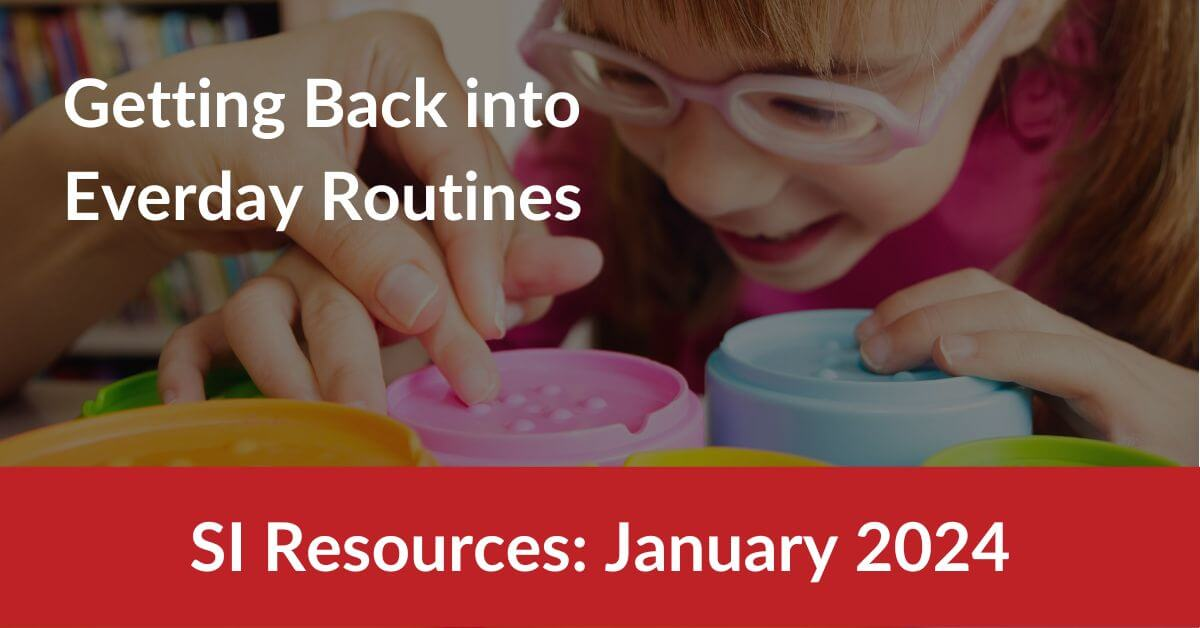
This month we're focusing on getting back into everyday routines.
With the festive season behind us and a new year already underway, it can sometimes be a struggle to settle back into a daily routine. While the new year can be an exciting time, for individuals with sensory integration or processing difficulties, it can also be anxiety-provoking as it brings its own challenges with changes in routines.
In this month's SI Resources, we've included lots of useful information, articles, resources, books and products to help support individuals with sensory differences who are struggling to get back into their everyday routines.

Morning Sensory Routines to Get the Day Started on The Right Foot – children can often struggle with getting up in the morning, getting out the door, or being focused at school or nursery. This great blog post from Your Kid’s Table highlights seven morning sensory routines that offer simple sensory activities and strategies for when a child wakes up that help balance and regulate their sensory system, often positively impacting the rest of their day.
Supporting Children with Sensory Processing Needs in the Early Years – this useful PDF document from Cumbria County Council does a deep dive into the eight sensory systems and key considerations when planning an Early Years environment and routines to meet the needs of children with sensory differences.
‘I Promise I'm Not Trying to Be Inconsiderate’ – this interesting article from Psychology Today looks at how neurodivergent people are often misunderstood in social situations and how the 'double empathy problem' asserts that we are most likely to understand individuals of our own neurotype. The article discusses how appreciation for neurodiversity and differences in communication could help bridge this gap.
Eating with Your Eyes and Gut? How Your Brain Decides When to Eat - this is an interesting read from Neuroscience News on the role that processing of sensory information plays in eating and choosing when to eat.
A Physiotherapist's Experience of SI Training (youtube.com) - Emma Snowdon BSC (hons) MCSP, Paediatric Physiotherapist and Advanced Sensory Integration Practitioner, shares her experience of how training as a SI practitioner transformed her career, having started as a Physiotherapist in the NHS. Emma also shares a unique example of how her SI training allowed her to think beyond her physio training and help a client balance on one leg.
Nonverbal Learning Disabilities: NVLD vs Autism - this insightful article from Autism Parenting Magazine looks at non-verbal learning disabilities (NVLD) and autism and how the two conditions aren't always intertwined.
Books and Product Ideas
 |
The ADHD Parenting Guide for Girls
The challenges and opportunities of parenting girls with ADHD are completely different from those of parenting boys. The purpose of this guide* is to shed light on the ‘invisible’ symptoms of ADHD affecting girls aged 3–17. It also provides targeted coping strategies to help them manage their symptoms better.
|
 |
My Thoughts and Feelings Journal
This is a wonderfully creative journal for self-reflection, creativity and expression – especially for children who struggle to express their feelings and emotions. The journal provides plenty of space (two pages per day) to work with and isn't dated so that the child doesn't feel pressured to write in it every day. There are various prompts throughout the journal to help the child reflect on their day and explore their feelings.
|
 |
The Teens' Workbook to Self-Regulate
On the surface, you see a highly sensitive and irritable teenager. But look closer, and you will notice a young person showing signs of emotional distress. This workbook* is a valuable resource that is broken down into two parts: cognitive techniques and behavioural techniques, and provides teens with exercises that reinforce skills such as knowing how and when to stop, breathe, and return to a normal state when feeling overwhelmed.
|
 |
The Lemonator
With mindful messages and a friendly approach to self-regulation, this book* is a great resource to help children understand their emotions, thoughts and behaviours better. The Lemonator is a brave and determined lemon who goes on an epic journey each day to find his fellow fruits and friends who are all in need of some help and a bit of a ‘squeeze.’
|
 |
Glow in the Dark Balloon Dog Stress Toy
This squeezy, glow-in-the-dark balloon dog* makes a great stress relief toy for individuals with sensory processing differences. No batteries are required and the more you play, the better it glows! It provides a great source of sensory stimulation and helps to improve focus, concentration and co-ordination. It's also a useful size for carrying around with you so that you can fidget and squeeze away to help you relax.
|
 |
Pop-it Fidget Diary
This pop-it fidget diary* is a great sensory toy to help calm high-stress situations at school, home or in the workplace. The hardcover diary uses bubbles that can be pressed and comes in a standard A5 size.
|

|
Magnetic Fidget Pen
This multi-functional fidget magnetic writing pen* is ideal for individuals who like to seek out sensory tactile input. A great decompression finger fidget toy for children and adults alike, it can change shape and be rotated and transformed into a variety of creative diverse shapes and figures. NB Please note this is not suitable for children under 12 years old.
|

|
Scentos Craft Sensory Set
This craft sensory set allows children to explore, learn and create. It’s ideal for sensory time with tactile and colourful items that smell amazing with yummy, fruity scents that will tickle their senses too! It will help to inspire and spark their creativity as well as develop their artistic skills and talents.
|
|
*Affiliate link: SIE may earn a commission (at zero cost to you) when you purchase by clicking on an affiliate link.
NB: Sensory Integration Education is not responsible for the content on external websites. Sharing a resource does not imply endorsement by Sensory Integration Education.
|











